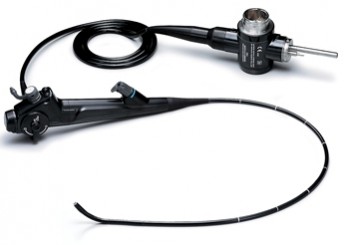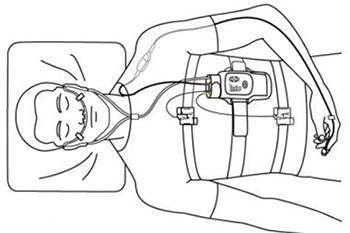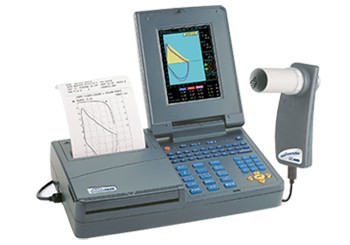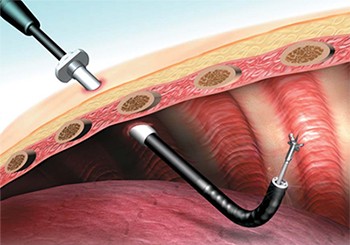Bronchoscopy is a test to view the airways and diagnose lung disease. It may also be used during the treatment of some lung conditions. Best Bronchoscopy Hospital in Nashik.
Instrument Used
We use a latest Bronchovideoscope by OLYMPUS- BF 1TQ 170.
Key Features
- Excellent image quality High-resolution image quality.
- NBI (Narrow Band Imaging) NBI is an optical image enhancement technology that improves the visualization of vessels on the mucosal surface.
- Wider EndoTherapy device capability The large 2.8 mm instrument channel diameter enables the use of various types of EndoTherapy devices for the 2.8 mm channel outlet.
How the Test is Performed
A bronchoscope is a device used to see the inside of the airways and lungs. The scope can be flexible or rigid. A flexible scope is almost always used. It is a tube less than 1/2-inch wide and about 2 feet long. In rare cases, a rigid bronchoscope is used.
The scope is passed through your mouth or nose through your windpipe (trachea) and into your lungs. Going through the nose is a good way to look at the upper airways. Going through the mouth allows the doctor to use a larger bronchoscope. If a flexible bronchoscope is used, you will probably be awake but sedated. During the procedure.
- You will likely get medicines through a vein (intravenously) to help you relax. Or you may be asleep under general anesthesia, especially if a rigid scope is used.
- A numbing drug (anesthetic) will be sprayed in your mouth and throat. If bronchoscopy is done through the nose, numbing jelly will be placed in one nostril.
- The scope is gently inserted. It will likely make you cough at first. The coughing will stop as the numbing drug begins to work.
- The doctor may send saline solution through the tube. This washes the lungs and allows the doctor to collect samples of lung cells, fluids, and other materials inside the air sacs. This part of the procedure is called a lavage.
- Sometimes, tiny brushes, needles, or forceps may be passed through the bronchoscope to take very small tissue samples (biopsies) from your lungs.
- The doctor can also place a stent in the airway or view the lungs with an ultrasound during the procedure.
- Sometimes ultrasound is used to view the lymph nodes and tissues around the airways.


How to Prepare for the Test
Follow instructions on how to prepare for the test. You will likely be told.
-
- Not to eat or drink anything 6 to 12 hours before the test.
- Not to take aspirin, ibuprofen, or other blood-thinning drugs before the procedure. Ask the doctor who will do the bronchoscopy and when to stop taking these drugs.
Arrange for a ride to and from the hospital.
- Arrange for help with work, child care, or other tasks, as you will likely need to rest the next day.
Usually, the test is done as an outpatient procedure and you will go home the same day. Some patients may need to stay overnight in the hospital.
How the Test will Feel
Local numbing medicine (anesthetic) is used to relax and numb your throat muscles. Until the medicine begins to work, you may feel fluid running down the back of your throat. This may cause you to cough or gag.
Once the medicine takes effect, you may feel pressure or mild tugging as the tube moves through the windpipe (trachea). Although you may feel like you are not able to breathe when the tube is in your throat, there is no risk of this happening. The medicines given to relax you help with these symptoms and you will likely forget most of the procedure.
When the anesthetic wears off, your throat may be scratchy for several days. After the test, your ability to cough (cough reflex) will return in 1 to 2 hours. You will not be allowed to eat or drink until your cough reflex returns.
Why the Test is Performed
You may have a bronchoscopy to help your doctor diagnose lung problems. Your doctor will be able to inspect the airways or take a biopsy sample.
Common reasons to perform a bronchoscopy for diagnosis are.
- Lung growth, lung cancer, lymph node, ⦁ atelectasis, or other changes seen on an x-ray or other imaging test.
- Suspected interstitial lung disease.
- Coughing up blood (hemoptysis).
- Possible foreign object in the airway.
- Cough that has lasted more than 3 months without any other explanation.
- Infections in the lungs and bronchi that cannot be diagnosed any other way or need a certain type of diagnosis.
- Inhaled toxic gas or chemicals.
- Inhaled toxic gas or chemicals.
You may also have a bronchoscopy to treat a lung or airway problem, such as to
- Remove fluid or mucus plugs from your airways.
- Remove a foreign object from your airways.
- Widen (dilate) an airway that is blocked or narrowed.
- Drain an abscess.
- Treat cancer using a number of different techniques.
- Wash out an airway (therapeutic lavage).
Normal Results
Normal cells and fluids are found. No foreign substances or blockages are seen.
What Abnormal Results Mean
Many disorders can be diagnosed with bronchoscopy, including:
- Infections from bacteria, viruses, fungi, parasites, or tuberculosis.
- Lung damage related to allergy-type reactions.
- Lung disorders in which the deep lung tissues become inflamed and then damaged.
- Lung cancer or cancer in the area between the lungs.
- Narrowing (stenosis) of the trachea or bronchi.
- Sarcoidosis.
- Vasculitis.
- Other inflammatory lung disease.
Risks
Main risks of bronchoscopy are:
- Bleeding from biopsy sites.
- Infection.
There is also a small risk of:
- Arrhythmias
- Breathing difficulties
- Fever
- Heart attack, in people with existing heart disease
- Low blood oxygen
- Pneumothorax (collapsed lung)
- Sore throat
Best Bronchoscopy Hospital in Nashik | Bronchoscopy Hospital in Maharashtra India




